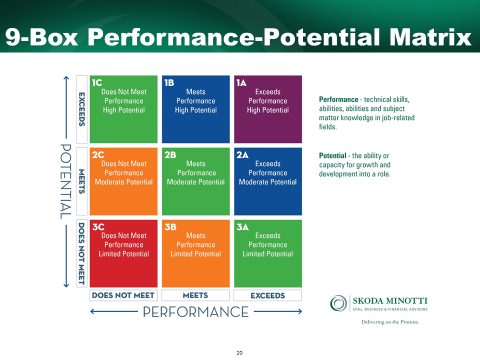Three Essential Tools for Managing Performance Throughout a Business
By Laura Rohde, Chief Learning Officer
In today’s ultra-competitive business environment, short-term profits aren’t the only measure of organizational success. Yes, profits matter. But to achieve sustainable success and vitality over the long-term, businesses and organizations must strive to be healthy in every way. As we’ve said in previous blogs, human assets are the essential drivers of organizational health. To build it – and to nurture it over time – your people must perform well today—and continually improve their performance.
High-performing businesses establish and maintain strategic performance initiatives that help employees chart defined paths toward improved performance, and ultimately, ever-greater rewards. In this blog, we highlight three tools that our Human Resources Services Group utilizes with clients for managing their employees’ performance and enhancing health, both individually and organizationally.
- Establish coaching and mentoring programs. We recommend robust coaching and mentoring programs for businesses of all sizes and scopes. Coaches and mentors both provide feedback and advice, albeit with different end goals in mind. So, what differentiates a coach from a mentor?
The dictionary defines coaching as “An ongoing process acknowledging both positive and constructive performance.” Whatever business you’re engaged in, a coach for performance is someone who generally is a level or two above the employee to be coached, understands the technical aspects of the employee’s job and can offer informed advice about it. Having likely walked in the employee’s shoes before, they are uniquely equipped to help shape future behavior—specifically, ways that employee can be more efficient and accurate in their work and in their role within the business.
Conversely, a mentor generally is a leader of some sort who provides career advice and helps the employee navigate culture. They don’t necessarily need to have worked a similar role in the past and walked in that employee’s shoes; but they should be charged with asking deep-rooted questions (e.g., “Where do you want to be in five years?”), and based on the employee’s responses, they should plan a roadmap together and help to put the employee in front of the right people when appropriate.
Beyond just establishing coaching and mentoring initiatives, real success for your business lies in identifying people in it to serve in these roles. Chances are, they do exist; some people simply enjoy helping others, so whether you choose to incentivize coaching or mentoring, it’s vitally important to fill these roles with people who are qualified and eager to participate.
- Put goal-setting processes and tools in place that measure goals relative to performance.
Once you have coaches in place working directly with designated employees, part of their job is to collaborate with the employee on appropriate goals. The intended deliverable of that should be two to three goals that the employee will strive to accomplish in a defined time period—e.g., annually, biannually or quarterly. Our Human Resources Services Group recommends that at least one goal should be a company-centric goal—i.e., what do you (employee) plan to do to enhance company health and/or performance, and what will your specific role in that be? We further recommend that a second goal should be centered around learning and development—i.e., what is one thing you plan to do to make yourself better during this upcoming period within the evaluation cycle? Maybe the employee wants to learn a new skill, get involved in a project or improve a process.
Whatever the employee’s goals may be, the coach should be responsible for ensuring that they align with the widely accepted S.M.A.R.T. model (Specific, Measurable, Attainable, Relevant and Time-Sensitive).
-
 Utilize a 9-Box Performance-Potential Matrix to evaluate performance against goals and apply appropriate rewards. As the accompanying diagram shows, the 9-Box Performance-Potential Matrix is a simple and effective tool that is designed to help coaches evaluate employees and develop rewards that are fair, so the right talent receives the right rewards. As the name implies, it aligns performance metrics (technical skills, abilities and subject-matter knowledge in job-related fields) with potential metrics (i.e., the ability or capacity for growth and development in a role).
Utilize a 9-Box Performance-Potential Matrix to evaluate performance against goals and apply appropriate rewards. As the accompanying diagram shows, the 9-Box Performance-Potential Matrix is a simple and effective tool that is designed to help coaches evaluate employees and develop rewards that are fair, so the right talent receives the right rewards. As the name implies, it aligns performance metrics (technical skills, abilities and subject-matter knowledge in job-related fields) with potential metrics (i.e., the ability or capacity for growth and development in a role).
The 9-Box is a time-tested and proven tool across many different organization types; but success rests on truthful and transparent communication, which underscores the importance of establishing and maintaining strong, trusting coaching relationships.
The End Goal: Healthy Organizations Driven by Engaged Employees at Every Level
Think about where this all leads. If one employee improves their performance, then your business itself has improved as well. And if your business embraces the tenets of continuous performance improvement at every level, then as every employee improves their performance, your business improves by leaps and bounds. You’ll have a smarter and more effective workforce. You’ll also stand a much better chance of retaining employees which, given today’s war on talent, is an enormous competitive advantage. Today, the number-one reason why employees stay with their employers is the opportunity to be challenged. When your business institutes a framework of continual performance improvement and empowers employees and coaches to perform within it, a truly healthy organization – and corresponding ROI – is the inevitable result.
If you have questions about managing performance throughout your business, or other human resources issues, please contact Laura Rohde at 330.564.8585 or email Laura.



















